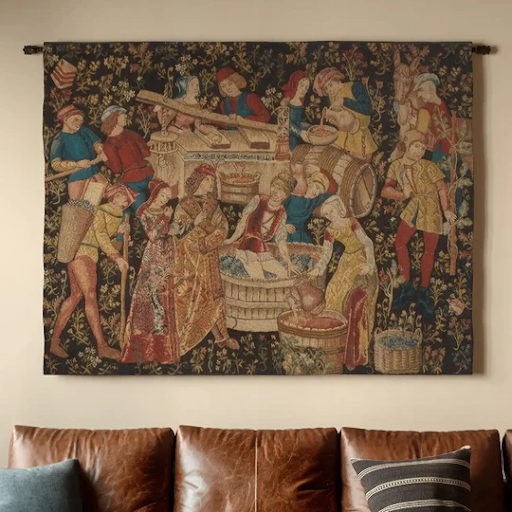
Wall hanging tapestries are a versatile and stylish way to add character, warmth, and visual interest to any room. They come in a variety of designs, textures, and sizes, making them ideal for living rooms, bedrooms, or even office spaces. Tapestries can transform a plain wall into a focal point, reflect personal style, and even serve as a form of insulation or sound dampening. Understanding the differences between lightweight and heavy wall hanging tapestries can help you choose the perfect piece for your space while balancing aesthetics and practicality.
Advantages of Lightweight Wall Hanging Tapestries
Easy Installation
Lightweight tapestries are easier to hang, requiring minimal hardware. They can often be attached with hooks, adhesive strips, or small nails, making them ideal for renters or those who want flexibility in rearranging décor.
Versatility in Spaces
Because of their light nature, these tapestries can be used in multiple ways: as wall art, bedspreads, or even draped over furniture. Their portability makes them suitable for smaller apartments or spaces that are frequently reconfigured.
Affordable Options
Lightweight wall hanging tapestries are often less expensive than heavier alternatives due to thinner fabrics and less intricate weaving. For beginners or those experimenting with vintage tapestry wall hangings, they offer an accessible entry point to decorating with textile art.
Easy Maintenance
Cleaning and storing lightweight tapestries is simpler. They can be folded or rolled without risk of creasing heavy fabrics, and washing them is usually less cumbersome.
Advantages of Heavy Wall Hanging Tapestries
Durability and Longevity
Heavy tapestries, often woven with dense fibers, are built to last. They are less prone to wear and tear, making them excellent investments for collectors of antique tapestry wall hangings or heirloom pieces.
Enhanced Visual Impact
Thicker and heavier fabrics create a more pronounced presence on walls. They can anchor a room, adding depth and sophistication, especially when featuring detailed designs like the tree of life tapestry.
Acoustic and Thermal Benefits
Heavy tapestries can help reduce echoes in large rooms and provide extra insulation against cold walls. This functional advantage makes them ideal for open spaces or drafty areas.
Rich Texture and Detail
Dense weaving allows for intricate patterns and a three-dimensional feel. Heavier wall hanging tapestries often showcase the skill of artisans and craftsmanship, making them a centerpiece of interior décor.
Factors to Consider When Choosing Between Lightweight and Heavy Tapestries
Room Size and Layout
In smaller rooms, lightweight tapestries may be preferable to avoid overwhelming the space. Larger rooms or spaces with high ceilings can handle heavy tapestries that make a statement.
Purpose of the Tapestry
If the goal is purely decorative or for seasonal rotation, lightweight options are convenient. For long-term display, insulation, or collector’s value, heavy tapestries provide longevity and a richer appearance.
Hanging Method
Consider the wall type and available hardware. Heavy tapestries require strong support like rods, brackets, or reinforced hooks, while lightweight tapestries can be displayed with minimal setup.
Maintenance and Care
Frequent cleaning and repositioning favor lightweight fabrics. Heavier fabrics may require professional cleaning and careful handling to prevent stretching or damage.
Popular Styles and Themes
Vintage Tapestry Wall Hangings
Vintage pieces offer a nostalgic charm and often depict historical scenes or intricate patterns. They can be found in both lightweight and heavy fabrics, allowing homeowners to match their aesthetic preferences with practical needs.
Antique Tapestry Wall Hangings
Antique wall hangings carry significant value, both monetarily and decoratively. Due to their age and material, these are usually heavier and require proper installation and care to preserve the artwork.
Tree of Life Tapestry
The tree of life tapestry is a timeless motif symbolizing growth, strength, and connection. These tapestries come in various sizes and weights, and the choice between lightweight or heavy fabric depends on the desired visual impact and hanging location.
Tips for Hanging and Displaying Tapestries
Use Appropriate Hardware
Select rods, hooks, or adhesive strips based on the tapestry’s weight. Heavy wall hanging tapestries need strong anchors, while lightweight fabrics can be hung with simple nails or clips.
Layering and Framing
Consider layering a lightweight tapestry over another textile or using a frame for extra support. Heavy tapestries can be displayed alone as a focal piece, enhancing texture and depth.
Rotate and Maintain
To keep colors vibrant and fibers intact, avoid prolonged exposure to direct sunlight. Rotate tapestries seasonally or when redecorating to minimize fading and wear.
Conclusion
Choosing between lightweight and heavy wall hanging tapestries depends on your space, intended use, and personal style. Lightweight options offer versatility, affordability, and ease of maintenance, making them suitable for temporary displays or small spaces. Heavy tapestries provide durability, visual impact, and functional benefits like insulation and sound dampening, ideal for long-term displays or collector pieces. Whether you opt for vintage tapestry wall hangings, invest in antique tapestry wall hangings, or select a symbolic tree of life tapestry, understanding the pros and cons of each type ensures a harmonious and stylish addition to your home décor.